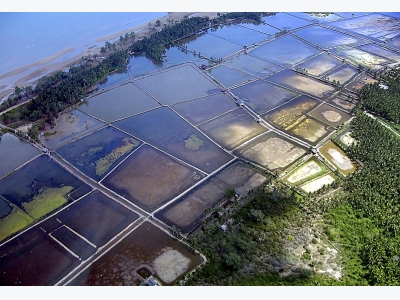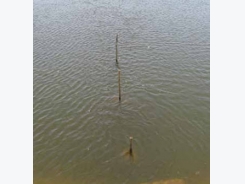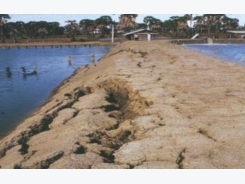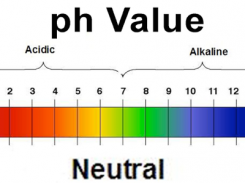Acute Hepatopancreatic Necrosis Disease Aetiology Epidemiology Diagnosis Prevention

Acute Hepatopancreatic Necrosis Disease
Aetiology Epidemiology Diagnosis Prevention and Control References
Acute hepatopancreatic necrosis disease (AHPND) emerged as a new disease of shrimp in 2010. The disease is sometimes referred to as early mortality syndrome, which is a broader term used to describe a range of shrimp health problems that lead to early mortality. The information presented in this technical fact sheet reflects the epidemiological observations and research information available to date (December 2013),together with additional data on Vibrio parahaemolyticus.
AETIOLOGY
Classification of the causative agent
AHPND has a bacterial aetiology. A bacterial isolate identified as a member of the Vibrio harveyi clade, most closely related to Vibrio parahaemolyticus, has been found to cause AHPND experimentally. Further studies to characterise the causative agent, including genetic characterisation, are continuing.
Resistance to physical and chemical action
Data are from transmission experiments for AHPND and strains of V. parahaemolyticus occurring in seafood:
Temperature:
Freezing – Attempts to transmit AHPND using infected frozen shrimp have been unsuccessful. Strains of V. parahaemolyticus in seafood are known to be sensitive to freezing (–18 to –24°C) and reductions in culturable cells to non-detectable levels have been reported after freezing for several weeks. Time of total inactivation depends on the initial number of bacteria and temperature.
Refrigeration – Strains of V. parahaemolyticus in seafood are known to be sensitive to refrigeration (4°C) and reductions in culturable cells have been reported, but not to nondetectable levels during the storage life of seafood products at this temperature.
Heating – Strains of V. parahaemolyticus in seafood are known to be sensitive to heating and reductions in culturable cells to non-detectable levels have been reported at 55°C for 5 minutes and 80°C for 1 minute.
Chemicals/ Disinfectants:
Susceptible to common disinfectants. No culturable cells after exposure to pH 5 for 15 minutes
Survival:
Survival to 9 and 18 days in filtered estuarine water and filtered seawater respectively. Densities of V. parahaemolyticus in seawater are known to be temperature dependant
EPIDEMIOLOGY
Hosts
AHPND has been reported from farmed populations of the following shrimp species:
- Penaeus vannamei
- Penaeus monodon
- Penaeus chinensis
Transmission
AHPND has been transmitted experimentally by immersion and reverse gavage. Based on these experiments, transmission by oral routes and cohabitation should be expected.
Occurrence
AHPND has been officially reported in China (People’s Rep. of) and Vietnam (2010), Malaysia (2011) and Thailand (2012) and Mexico (2013). AHPND is not listed by the OIE. However the disease does meet the definition of an emerging disease in the OIE Aquatic Animal Health Code (Aquatic Code). Member countries should consider their obligation to report any occurrence of the disease in accordance with Chapter 1.1 of the Aquatic Code
Food safety
Consumption of raw or undercooked seafood contaminated with V. parahaemolyticus can lead to development of acute gastroenteritis in humans. Results of preliminary investigations of AHPND did not detect the human pathogenic strains producing thermostable direct haemolysin (TDH) and TDH-related haemolysin (TRH), in the V. parahaemolyticus causing AHPND. There has been no report of human-related disease (e.g. gastroenteritis) linked to the consumption of affected shrimp from any of the affected countries since the emergence of AHPND (FAO, 2013).
DIAGNOSIS
A disease card for AHPND is available from the Network of Aquaculture Centres in Asia Pacific (NACA: see references).
Clinical diagnosis
Typical signs of AHPND begin within 10–30 days after stocking of post larvae into a newly prepared pond.
- The following signs may be observed:
- Hepatopancreas (HP) often pale to white due to pigment loss in the connective tissue capsule
- Significant atrophy (shrinkage) of HP
- Often soft shells and guts with discontinuous contents or no content
- Black spots or streaks sometimes visible within the HP
- HP does not squash easily between thumb and finger
- Onset of clinical signs and mortality starting as early as 10 days post-stocking
- Moribund shrimp sink to the bottom
Histopathology
- Acute progressive degeneration of the HP accompanied initially by a decrease of R-, B- and Fcells followed last by a marked reduction of mitotic activity in E-cells
- Progress of lesion development is proximal to distal with dysfunction of R-, B-, F-, and lastly Ecells, with affected HP tubule mucosal cells presenting prominent karyomegaly (enlarged nuclei), and rounding and sloughing into the HP tubule lumens
- The sloughed HP cells provide a substrate for intense bacterial growth, resulting in massive secondary bacterial infection and complete destruction of HP at the terminal phase of the disease
- Accompanying the initial sloughing of HP tubule epithelial cells and the development of a secondary bacterial infection is intense intertubular haemocytic aggregation and haemocyte encapsulation of necrotic HP tubules and melanisation of the more proximal portions of HP tubules in some shrimp
Laboratory diagnosis
Samples
For culture of bacteria:
Live shrimp
For histopathology:
Whole juvenile shrimp fixed in Davidsons fixative
For molecular tests:
Whole juvenile shrimp fixed in 100% ethanol or frozen
Procedures
Identification of the agent
- Bacterial culture
- Biochemical methods
- PCR and sequencing
Histopathology
Demonstration of characteristic histopathology
PREVENTION AND CONTROL
| Commodity | Relevant knowledge | Likelihood of transmission to farmed or wild shrimp populations |
| Live shrimp for aquaculture | AHPND has been transmitted experimentally by immersion. Transmission by cohabitation is expected. Penaeus monodon, P. chinensis and Penaeus vannamei are known to be susceptible. | High |
| Fresh dead shrimp for human consumption | AHPND has been transmitted experimentally by immersion and reverse gavage, and transmission by the oral route is likely. Vibrio parahaemolyticus is sensitive to refrigeration but will remain viable for several weeks in chilled aquatic animal products. | Low Transmission would require the existence of pathways for exposure of susceptible populations. |
| Frozen shrimp for human consumption | Attempts to experimentally transmit AHPND from frozen shrimp tissues have failed. Freezing has been shown to reduce the number of culturable V. parahaemolyticus but may not eliminate bacteria entirely. Time to total inactivation depends on the initial number of bacteria and temperature. | Negligible Transmission would require the existence of pathways for exposure of susceptible populations. |
| Live shrimp feed | AHPND has been transmitted experimentally by immersion and reverse gavage, and transmission by the oral route is likely. Live feeds (e.g. for hatchery brood stock) may present a transmission pathway if sourced from populations in AHPND endemic areas. | High |
| Manufactured shrimp feeds – extruded | AHPND has been transmitted experimentally by immersion and reverse gavage, and transmission by the oral route is likely. Vibrio parahaemolyticus does not tolerate heating and is not expected to survive commercial feed manufacturing processes where temperatures reach 100C for at least 1 minute | Negligible |
Related news
Tools

Phối trộn thức ăn chăn nuôi

Pha dung dịch thủy canh

Định mức cho tôm ăn

Phối trộn phân bón NPK

Xác định tỷ lệ tôm sống

Chuyển đổi đơn vị phân bón

Xác định công suất sục khí

Chuyển đổi đơn vị tôm

Tính diện tích nhà kính

Tính thể tích ao




 Water Quality in Aquaculture
Water Quality in Aquaculture  How to reduce pH in Aquaponics without so…
How to reduce pH in Aquaponics without so…